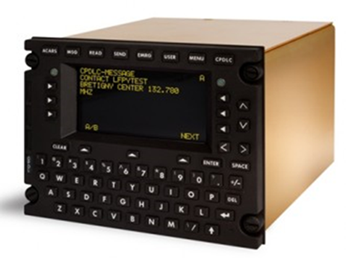

Fokker Services CPDLC upgrade for Boeing 757
Overview
Introduction
The Air Traffic Control (ATC) environment is slowly changing to Air Traffic Management (ATM). Part of the transition is the introduction of the Controlled Pilot Data Link Communications (CPDLC) with an operational mandate since February 2020 in accordance with EC regulation 2015/310.
CPDLC is an air/ground data-link, which enables the exchange of text messages between controllers and pilots. CPDLC complements traditional voice communications, providing pilots and controllers with an additional communications medium.
The objective of CPDLC is to improve the safety and efficiency of air traffic management by the introduction of datalink services for the single European sky.
Your needs
The Operational (European) Mandate for CPDLC is since February 2020 in accordance with EC regulation 2015/310.
Your benefits
As well as being required by law, the CPDLC integration offers multiple benefits to the fleet operator, pilot, and passengers alike. With this superior form of communication, the risk of pilots being forced to split focus will be reduced. The benefits include:
» Improves safety by reducing the probability of missed or misunderstood communications.
» Helps to eliminate the common problem of stuck microphones.
» Significantly reduces pilot workload in congested airspace as ATC data link messages are sent directly to the intended aircraft rather than being shared with other traffic.
» Increases flight communications efficiency by reducing the demand on ATC for various communication tasks and freeing this capacity to provide standardized clearances at a faster rate, simultaneously to multiple flight crews.
» Increased ATC awareness of operational preferences. The system can down-link aircraft preference and parameter data, including flight level preferences and meteorological conditions.
» Improves aeronautical meteorological reports and forecasts, which raises ATC and flight crew airspace environment awareness.
Product Description
For CPDLC the one box Dlink system will be installed in the pedestal. An Engineering Bulletin (EB) for the certified installation and manual supplements will be issued as well as a modification kit for each aircraft containing all necessary materials to complete the modification.
The SELCAL system and the VHF-COM 3 Antenna will be used. Some aircraft may already have a SELCAL installed, if not wiring can be included as an option. If the VHF-COM 3 Antenna and/or structural provisions-for are not available, Fokker Services can offer the VHF-COM 3 Antenna and structural provisions-for as well. The interface to the FMS can be offered as an option (depending on the FMS part number).
Your benefits
As well as being required by law, the CPDLC integration offers multiple benefits to the fleet operator, pilot, and passengers alike. With this superior form of communication, the risk of pilots being forced to split focus will be reduced. The benefits include:
» Improves safety by reducing the probability of missed or misunderstood communications.
» Helps to eliminate the common problem of stuck microphones.
» Significantly reduces pilot workload in congested airspace as ATC data link messages are sent directly to the intended aircraft rather than being shared with other traffic.
» Increases flight communications efficiency by reducing the demand on ATC for various communication tasks and freeing this capacity to provide standardized clearances at a faster rate, simultaneously to multiple flight crews.
» Increased ATC awareness of operational preferences. The system can down-link aircraft preference and parameter data, including flight level preferences and meteorological conditions.
» Improves aeronautical meteorological reports and forecasts, which raises ATC and flight crew airspace environment awareness.




